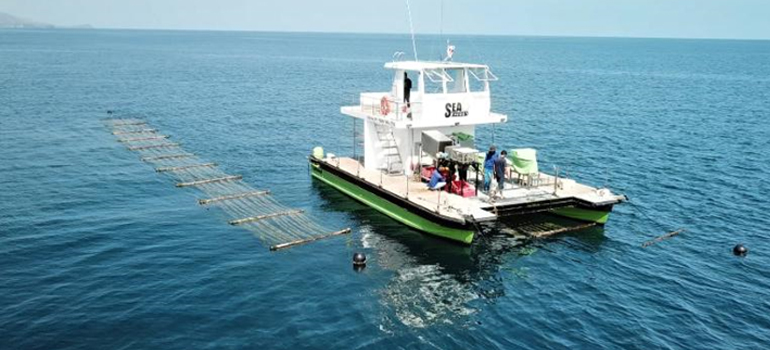An IITM alumnus founded startup could revolutionize ocean farming with its ‘sea combine harvester’
Usually, seaweed is grown on ropes or nets suspended in the ocean, but current techniques make large-scale cultivation near impossible. Ocean farming is in the “stone ages,” according to Shrikumar Suryanarayan, co-founder and CEO of Bangalore-based Sea6 Energy and former head of research and development at Biocon, an Indian pharmaceutical company specializing in biologically-sourced medicines. “It’s like using a trowel and a pick to farm land.”
Founded in 2010, Sea6 Energy wants to mechanize ocean farming, just as tractors did for agriculture, with its “Sea Combine,” an automated catamaran that simultaneously harvests and replants seaweed in the ocean.
The machine travels back and forth between lines of seaweed, harvesting the fully-grown plants and replacing them with freshly-seeded lines.
A prototype is currently deployed at the company’s seaweed farm off the coast of Indonesia. The Southeast Asian nation has a tradition of seaweed farming that involves villagers tying pieces of seaweed to ropes and hauling them out to sea, before manually harvesting the lines, and there is a strong appetite for the crop there, according to Suryanarayan. As the technology develops and the market widens, the company intends to deploy more Sea Combines, including in its home country, India.
While the global seaweed industry doubled in size between 2005 and 2015, and produced 33 million metric tons in 2018, labor-intensive and costly production is expected to impede market growth, according to market research firm Fortune Business Insights.
The price of seaweed restricts its potential uses, says Suryanarayan, and in the current market, it’s often only economically viable to use seaweed for high-priced food applications.
Suryanarayan hopes the Sea Combine will cut costs and make seaweed cheaper, so it can be more widely used. Doing this won’t hurt local livelihoods, he believes, as village cooperatives could lease the machinery, allowing them to farm a larger area.
Food and fuel
The Sea Combine is just “a tool” in Sea6 Energy’s wider operation, says Suryanarayan. The company, which has raised $20 million in funding, currently uses the seaweed harvested by the machine to manufacture products such as animal feed and agricultural fertilizer on a small scale, he says.
While Suryanarayan admits it’s been a slow journey for the company, mainly due to a lack of investment in its early years, he believes it is now at an “inflexion point,” as the foundations have been laid, technology developed, and there’s considerable interest worldwide in the potential of seaweed to mitigate climate change.
The company’s next step is to expand its range of seaweed-based products, starting with bioplastics, which it aims to begin producing in the next three years.
Seaweed has long been floated as a biodegradable alternative to plastic, with the EU funding research into it over the last decade. London-based startup Notpla has already used seaweed to create sustainable packaging for drinks and sauces. Sea6 Energy is in the early stages of developing its own biodegradable film to replace plastic and paper bags.
But the company’s boldest ambition is to convert seaweed to biofuel, helping to reduce India’s dependence on crude oil. Scientific research carried out by the company shows it would be technically feasible, but Suryanarayan admits there’s still a long way to go before it becomes commercially viable.
Vincent Doumeizel, director for the Food Programme at the Lloyd’s Register Foundation, a charity that supports research and innovation, and senior advisor at United Nations Global Compact (UNGC), the UN’s corporate sustainability initiative, is skeptical. “We would need hectares and hectares [of seaweed] to produce a few gallons of oil,” he tells CNN Business. “To me, producing seaweed for biofuel is like using gold for gravel.”
Instead, Doumeizel believes Sea6 Energy should focus on areas where seaweed can make an immediate difference. Seaweed-enriched cattle feed has the potential to
reduce bovine methane emissions because it contains compounds that stop microbes in a cow’s gut producing the gas; bioplastics could contribute to decarbonization; and the nutritious plants could help feed the world’s growing population, he says.
But first, industry investment needs to accelerate, says Doumeizel, adding that he welcomes the efforts of companies developing technology for industrial-scale cultivation.
Sea6 Energy is not alone in this. Norwegian company
Seaweed Solutions designed the “Seaweed Carrier,” a sheet-like structure that can grow large amounts of kelp in deep water, and Belgium-based
AtSeaNova has developed a floating seeding and harvesting machine.
“Sea agriculture is one of the ways … to improve the sustainability of the planet,” says Suryanarayan. “Our job and journey will be well achieved if we can show that it is economically viable.”
Original News Link
https://edition.cnn.com/2022/01/05/business/india-sea6-energy-seaweed-harvester-spc-intl/index.html
